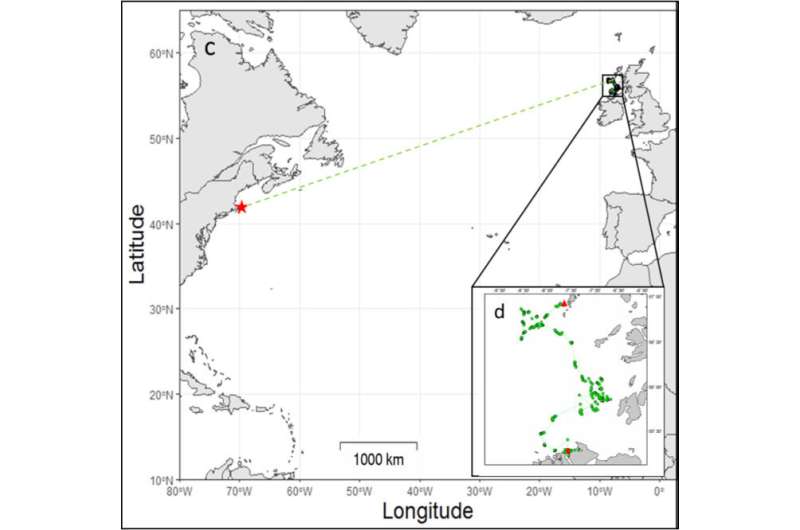Image (a) was taken by Emmett Johnston at Malin Head, Ireland. Image (b) was captured by Eric Savetsky nearly three years later off the coast of Cape Cod. Credit: Emmett Johnston/Eric Savetsky
Confirmation of a transatlantic crossing by a highly endangered marine animal signals the need for "an international mindset" when seeking ways to conserve the basking shark—named among the world's 'weirdest' animals by National Geographic.
Western and Queen's University Belfast recently detailed only the second recorded evidence of transatlantic movement for the world's second largest shark (after the whale shark).
This is the first proof of the movement in more than a decade. The last recorded evidence for transatlantic movement was gathered in 2008 when a female basking shark tagged with a tracking device moved from the Irish Sea to continental waters off the coast of Newfoundland.
This time around, images of another female basking shark were captured by an underwater photographer off the coast of Cape Cod an incredible 993 days after it was fitted with a satellite transmitter at Malin Head, the most northern point of Ireland.
Basking sharks are Canada's most endangered marine fish with its Pacific Ocean population almost extinct. Any confirmation of transatlantic movement for the large-mouthed leviathan is a game-changing finding.
The study is a collaboration between Biology professor Paul Mensink and a team of researchers from Queen's University Belfast led by Emmett Johnston and Jonathan Houghton.
Credit: University of Western Ontario
"For this animal to show up across the ocean three years after it was tagged in Ireland highlights that we really need an international mindset when seeking ways to conserve this species," Houghton said.
"In the era of big data, it is amazing how much these fortuitous re-sightings of individual animals can tell us about an entire species," Mensink said.
The study, "Serendipitous re‐sighting of a basking shark Cetorhinus maximus reveals inter‐annual connectivity between American and European coastal hotspots," was recently published in the Journal of Fish Biology.
More information: Emmett M. Johnston et al. Serendipitous re‐sighting of a basking shark Cetorhinus maximus reveals inter‐annual connectivity between American and European coastal hotspots, Journal of Fish Biology (2019). DOI: 10.1111/jfb.14163
Journal information: Journal of Fish Biology
Provided by University of Western Ontario

























